- NEW DVD Series – Stone Setting with Bezels
- Tube Set Charm by Kim St. Jean
- Prong Basket Pendant by Kim St. Jean
- NEW DVD Series – Stone Setting with Cold Connections
- New DVD Series – Stone Setting with Wire
- NEW DVD Series: Introduction to Stone Setting by Kim St. Jean
- Featured Tool: Bracelet Bending Plier
- NEW Dvd by Eva Sherman
- Fun, Fast Fold Forming DVD Series
- Double Band Ear Cuff from Alex Simkin
Coiled Wire Jewelry Series – Part 1
by Judy Ellis, Wirejewelry.com
Wire Jewelry Article for May 9th, 2016
Coiled Wire Jewelry: A 3 Part Series
by Judy Larson
From time to time we receive a series of contributor posts that seem to fit together perfectly (even if they aren’t planned that way) and the ones I’m going to share with you over the next few posts are no different.
Throughout this week I’ll be presenting three posts from Judy Larson that give you some history on Egyptian coils and early jewelry wire wrapping styles, along with tips on how to make them, and then a beautiful pattern to create a focal bead bracelet using coils. Today is Part 1 of this 3 part series.
Part 1 – Everything New is Old
Judy Says:
The dates of manufacture of the ancient jewelry items in this article are broad estimates. Metal and stone do not contain carbon and therefore cannot be carbon dated. But even with carbon dating of surrounding materials, guesstimates can span 1000 years or more for these ancient finds, whereas carbon dating of more modern items may only have a margin of error or 50-100 years. Once the pieces around the artifact have been dated, it is generally accepted that the stone or metal artifact is of that time period as well.
Coiled Wire Jewelry is older than you think, and the Egyptian coil is not really Egyptian.
- These three shell beads, 90,000 to 10,000 years old, with through and through holes have been identified as the earliest known pieces of
jewelry worn by man. Can you see them as part of a necklace or bracelet?
- According to Russian experts, this polished green stone bracelet, found in Siberia in 2008 and possibly 40,000 years old, is oldest stone
piece of jewelry ever found in the world.
Jewelry made with metal and wire is a relatively modern process, not available until man was able to work with metal to produce luxury items. Studies of archeological excavations show us that somewhere around 10,000 years ago man started to use metals such as copper, silver and tin to create tools, and maybe even adornment items. It was not until about 3,300BC, the beginning of the Bronze Age when man learned to combine metals to make alloys, that the art of creating jewelry blossomed.
Early Metals:
In the beginning, soft metals such as copper, silver and gold were pounded into sheets. Then, as metallurgy advanced, wire was made by drawing narrow strips of very thin metal through holes in stone beads, causing the strip to curl into itself and form into a thin tube.
This technique, seen in 2nd Dynasty Egyptian jewelry, was followed by rolling these tubes between two flat surfaces, making a more solid wire. Wire was shaped and coiled by early artisans into a variety of designs. It was also affixed to metal sheets for even more variety. It was not until between the 8th and 10th centuries AD in the Western world that drawing wire as we know it was used to produce wire.
Spirals are found worldwide across all cultures. It is found on cave walls, pottery, and even in writing, as in this hieroglyph quail chick: ![]() It is also one of the oldest designs in used jewelry. So, it comes as no surprise that some of the oldest pieces of metal jewelry contain coils as design elements.
It is also one of the oldest designs in used jewelry. So, it comes as no surprise that some of the oldest pieces of metal jewelry contain coils as design elements.
Sumerian Jewelry:
Sumer, located in the southernmost part of Mesopotamia between the Tigris and the Euphrates rivers, in the area that later became Babylonia and is now southern Iraq, was the site of the earliest known civilization.
A multitude of Sumerian jewelry artifacts, dated to 2,560BC, over 4,500 years ago, were excavated by Archeologist C. Leonard Woolley and his team between 1922 and 1934. Some of the most stunning pieces were recovered from what he described as “The Great Death Pit” of Ur.
These “Treasures from the Royal Tombs of Ur” are so timeless in design that they look like they could have been made by modern artisans.
The Sumerians believed it was necessary to bring gifts for the gods and goddesses of the underworld to insure the deceased had a comfortable stay in the afterlife. That is why the burial sites contain many, many jewelry items. Notice the beautiful coiled wire sections.
- This Sumerian necklace and ring, dated to the 2nd Millennium BC, are great examples of the exquisite craftsmanship of the time.
Babylonian Jewelry:
- These Ancient Babylonian Gold Lion-Head open spiral earrings are just stunning.
- This Babylonian necklace was made 3,500 years ago, 1,000 years after the jewelry found in the Royal Tombs of Ur. The swirl patterns and the shape of the gold beads continue the Sumerian tradition of jewelry.
- The coils look like what we think of as “Egyptian Coil” but even though the Egyptian Old Kingdom started around 2649BC, I could find no coil jewelry such as the Sumerians and Babylonians created.
- Coils were found on 3,500 year old Egyptian clay pots, seen at the Metropolitan Museum of Art in NYC, but coiled jewelry of this time period in Egypt has yet to be found.
The only jewelry piece I could find that had coils on it was this pectoral piece, displayed in the Cairo Antiquities Museum and dated to 1333-1323BC, that was found bound into the bandages that wrapped the mummy of Tutankhamen.
More Beautiful Examples – New is Old:
- 3,200 to 3,600 years ago, a skilled artisan created this Hungarian fibula, on display in the British Museum. It is a beautiful example of early “wire wrapping.”
- This twisted coiled wire double spiral, also 3,200 to 3,600 years old and on display at the British Museum, is made of gold.
- Mari, a flourishing city west of the Euphrates, was site where this beautiful 14-13th Century BC necklace was found.
- After this gorgeous 3,300 year old gold bracelet was unearthed, archeologists were stumped as to where it was made and how it came to be found in northern Germany.
- This gold earring, quite modern in design, dates to 1600BC in Mycenaean Greece.
- This diadem was produced in the prolific and technologically accomplished workshops in the Carpathian Mountains in Europe somewhere between 1200–800BC. It was probably worn with the spirals at the back of the head and pointing downward.
- These bronze rings made in Central Europe during the Bronze Age look to be the inspiration for the Alexander Calder ring at the end of this article.
- This Mycenaean necklace, ca. 1400-1200BC, is made of tubes with attached spirals.
Do these spirals look familiar (think Egyptian Coil)?
Bronze Age European spirals of this type were often used in ornamentation during the Mid to Late Bronze Age.
- Two spirals of this type were found in most European burial sites of that time period, the meaning of which is unknown.
Athens, National Archaeological Museum. With the collapse of the Mycenaean world 1100-800 BC, the imaginations of artisans stagnated. Jewelry recovered from excavations in the area was simply made using wire or very thin sheet metal with no decorative touches beyond the spiral, as shown in this 8th century BC gold bead from Anavyssos.
When contact and trade with more advanced civilizations became more common, jewelry making became much more creative, but the spiral was still a mainstay of decoration.
- These simple spiral gold rings were produced during the middle of the 5th century BC.
- The pendant on this Thraco-Celtic woven silver necklace, ca 100BC-100AD, is made of two attached coiled wires with some granulation between the wires.
- The pendant shape, called a “lunula,” is found in many ancient civilizations as well as in modern jewelry design.
- This Early Anglo-Saxon 6th Century AD coiled silver hook-and-eye wrist clasp was found in Kenninghall, Norfolk, England.
- This silver wire spiral finger-ring, 5th-6th Century AD, seen in the British Museum, is a very familiar design, isn’t it?
(CLICK HERE to see Kate Richbourg create a 5-Minute Ring – modern version – just like this.)
Meanwhile…
On the other side of the world, artisans in the Americas created fabulous pre-Columbian golden works of art before European contact.
- This cast gold zoomorphic figure with twin attachment loops, ca. 500-1500AD from Columbia, Chiriqui or Diquis, is smaller than 2”x2” but is exhibits detailed scroll work.
- This gold 3″ pendant frog. ca 700-1500AD from Central America, shows more scroll/coil designs.
- This pre-Columbian 3.75″x3.25″pendant of a anthropomorphic frog-god holding a hoop decorated with spirals is dated 11th – 16th Century AD.
- On these Nazca gold earrings the wire is soldered to the central disc.
- The Zenu spiral, ca 300BC to 1500AD and found at Museo del Oro in Cartagena, looks particularly modern. It may have been inspiration to Alexander Calder’s Double Spiral Pin.
- On many of the islands of eastern Indonesia, instead of exchanging engagement rings, men traditionally gave earrings to the women they wished to marry. The shapes of the earrings could often evoke fertility, as with these ear ornaments, ca. 1800-1900AD.
American sculptor Alexander Calder (1898-1976) is known as the originator of the mobile. But he also loved working with wire and creating jewelry. Many of his pieces seem to be inspired by ancient jewelry works.
- This piece is similar to the Zenu spiral above.
The jewelry creations of Alexander Calder has a decidedly ancient feel. The ring looks like half of one of a Central European Bronze Age ring.
- This necklace was created by Alexander Calder in 1930 as a birthday present for his mother using brass wire, string and pieces of broken pottery and china.
Closing thoughts….
The world around them provided inspiration for ancient jewelry artisans. They found some designs, such as the spiral, were timeless and continued to use them in their creations.
Where do you find your inspiration? What design feature do you like to use often?
If you’d like to see more of Judy’s tips CLICK HERE!
Happy Wrapping!
![]()
More Resources:
Click to Receive Daily Tips by Email







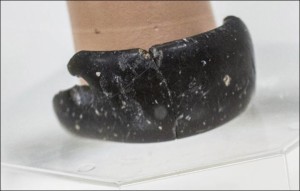



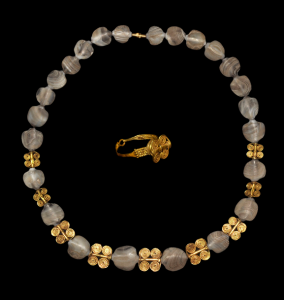
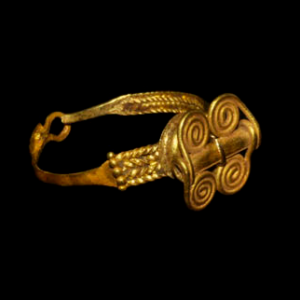
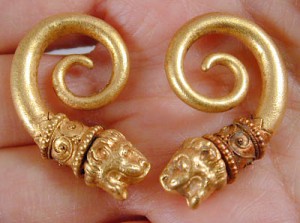

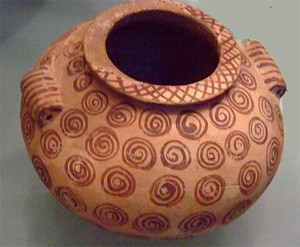
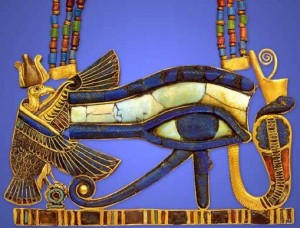

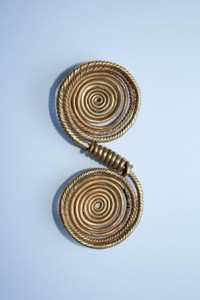
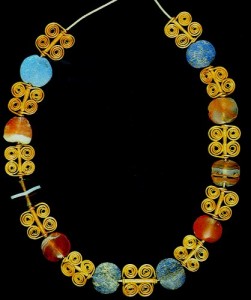







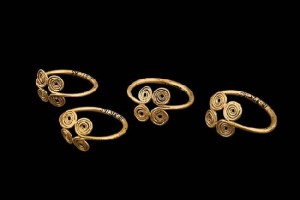


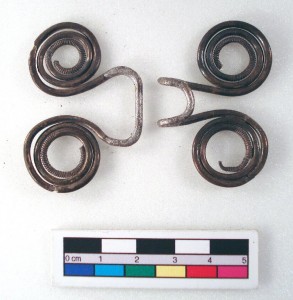


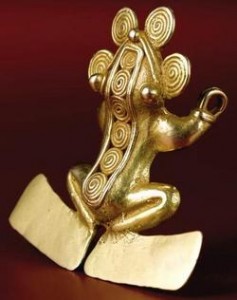
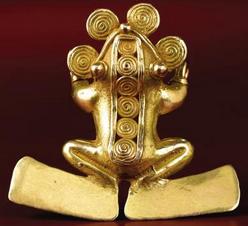
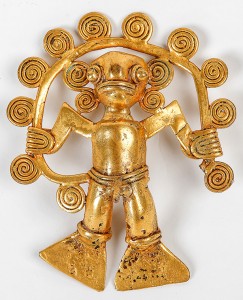
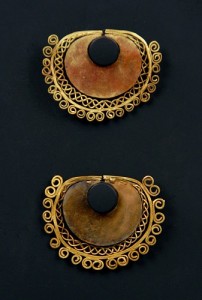
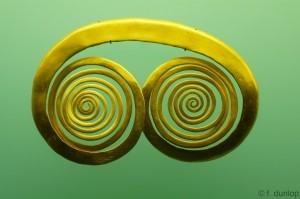

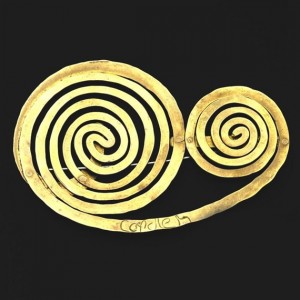



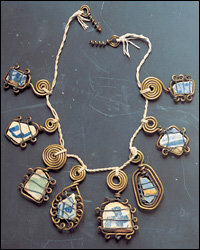

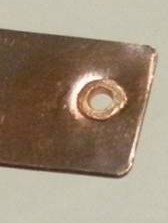


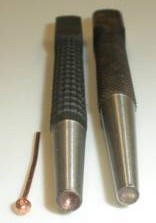














Judi Morningstar
May 10, 2016 at 1:59 pm
Great article. Thank you for posting it.
Amy Dreves
July 3, 2017 at 4:45 am
Thanks for compiling all in one place, what I had been searching for, in terms of the history of the Egyptian spiral chain. Your work is very thorough.